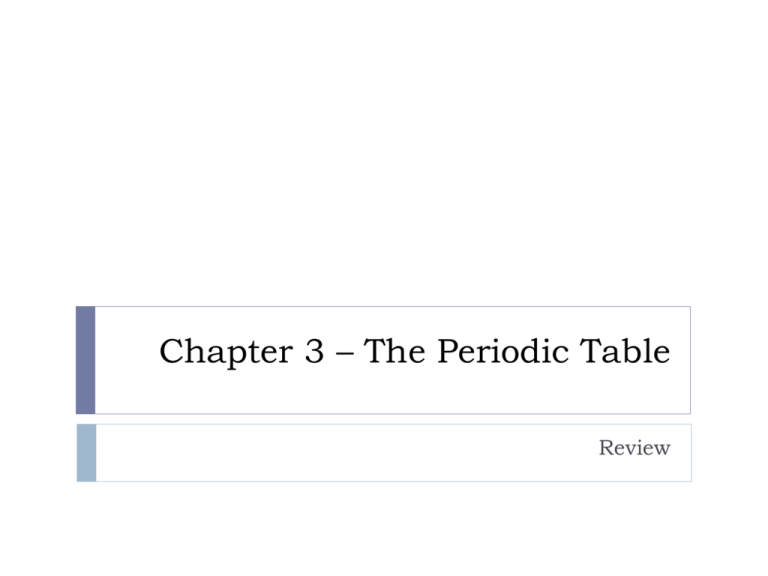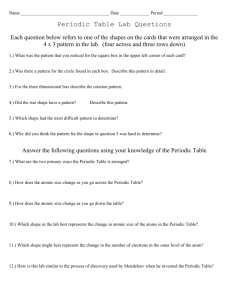Chapter 3 - The Periodic Table Review
advertisement

Chapter 3 – The Periodic Table Review Match the following scientist to the characteristics of their periodic tables. __ Mendeleev A. Followed the Law of Octaves __ Dobereiner B. Ordered elements according to increasing atomic mass. __ Mosley C. Grouped elements in triads __ Newlands D. Ordered elements according to increasing atomic number. Match the following scientist to the characteristics of their periodic tables. B Mendeleev A. Followed the Law of Octaves C Dobereiner B. Ordered elements according to increasing atomic mass. D Mosley C. Grouped elements in triads A Newlands D. Ordered elements according to increasing atomic number. What is the periodic law? What is the periodic law? The statement that the physical and chemical properties of the elements repeat in a regular pattern when they are arranged in order of increasing atomic number. Which elements are known as the representative elements? Which elements are known as the representative elements? The representative elements are those elements that are found in group 1, 2 and 13-18. (Also know as groups 1A, 2A, and 3A-18A) What element can be found in group 13 period 2? What type of element is it? What element can be found in group 13 period 2? Boron What type of element is it? Metalloid Which of the following elements are generally gases or brittle, dull-looking solids, and poor conductors of heat and electricity? Copper Phosphorus Platinum Argon Bromine Selenium Iridium Yttrium Which of the following elements are generally gases or brittle, dull-looking solids, and poor conductors of heat and electricity? Copper Phosphorus Platinum Argon Bromine Selenium Iridium Yttrium Non-metals are the only elements that have these characteristics Which of the following elements are generally shiny when smooth and clean, solid at room temperature, and good conductors of heat and electricity? Lithium Selenium Iodine Nickel Lead Scandium Tungsten Carbon Which of the following elements are generally shiny when smooth and clean, solid at room temperature, and good conductors of heat and electricity? Lithium Selenium Iodine Nickel Lead Scandium Tungsten Carbon Metals are the only elements that have these characteristics Which of the following are elements with physical and chemical properties of both metals and nonmetals? Molybdenum Silver Germanium Gold Calcium Arsenic Antimony Carbon Which of the following are elements with physical and chemical properties of both metals and nonmetals? Molybdenum Silver Germanium Gold Calcium Arsenic Antimony Carbon Metalloids are the only elements that have these characteristics How many valence electrons do elements in group 13 of the periodic table have? How many valence electrons do elements in group 13 of the periodic table have? 3 Which one of the following elements would tend to form ions with a positive charge? Phosphorus Calcium Xenon Which one of the following elements would tend to form ions with a positive charge? Phosphorus Calcium Xenon Why don’t noble gases form ions? Why don’t noble gases form ions? They have a full octet of electrons and have no need to gain or lose electrons What is the term that describes an atoms ability to attract electrons? What is the term that describes an atoms ability to attract electrons? Electronegativity Which of the following elements would have the larger atomic radius? Calcium or Chromium Which of the following elements would have the larger atomic radius? Calcium or Chromium Which element would have the greater electronegativity? Sulfur or Oxygen Which element would have the greater electronegativity? Sulfur or Oxygen What is the name of the chemical family that is in group 2 of the periodic table? What is the name of the chemical family that is in group 2 of the periodic table? Alkaline Earth Metals What is the name of the chemical family that is in group 17 of the periodic table? What is the name of the chemical family that is in group 17 of the periodic table? Halogens What is the name of the chemical family that is in group 1 of the periodic table? What is the name of the chemical family that is in group 1 of the periodic table? Alkali Metals What is the name of the elements that are in group 3-12 of the periodic table? What is the name of the elements that are in group 3-12 of the periodic table? Transition Metals




